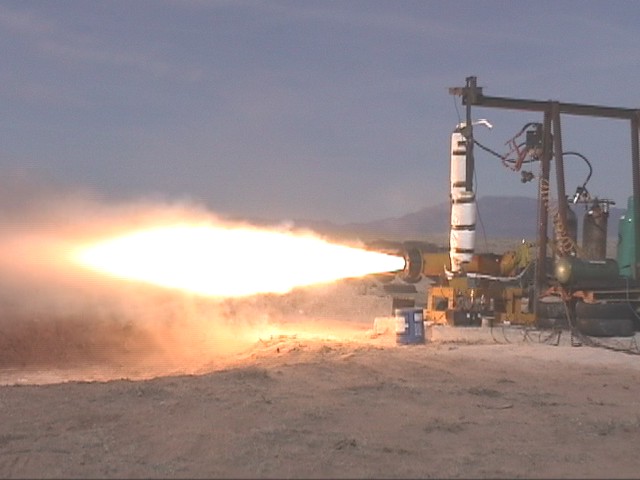Site Search
ProPEP Data
Projects
Collaborative Rocket
The FAQs
References
General Engineering
Mechanical/Materials
For Beginners
Ray's Tutorial
Operations/Safety
Environment
The Shop
Legal Issues
Aeronautics
Guidance
Electonics
Propulsion
Chemistry
Analysis
Structures
History
Email Ray
Liquid Oxygen Hybrid
One of the projects currently in test and development at the aRocket test site out here in New Mexico, is this Liquid Oxygen hybrid rocket.

This motor is designed to produce thrust in the range of 2,000 to 3,000 pounds force. In it's first test, it produced approximately 20,000 lb-sec total impulse before emptying the LOx run tanks. It burned a little under half of it's solid fuel, and longer runs to approximately 30,000 lb-sec total impulse are planned.
The photo above was taken during the first hot flow test, where the motor did not maintain it's full designed thrust due to inadequate LOx flow:
Here is the graph of the motor parameters during the test.
There was no indication of combustion instability despite the appearance of the thrust curve. This is noise from amplifying a 35,000 lb load cell to provide usable output in the 3,000 lb range. Note that it exists before and after combustion.
A new LOx feed system is being constructed to solve this problem. Testing will resume upon it's completion. The 60 gallon LOx run tank has been fabricated and the tank supports and plumbing interconnects are now being fabricated.
Early in the test, smoke came from the head end of the combustion chamber. About ten seconds later in the test, the cause of this became evident as we burned through the casing near the injector. A few factors contributed to this and are enumerated below.
1. Safety interlock thermocouples embedded in the ignitor were
slow to respond to the temperature increase and initiate
programmed LOx flow. This caused the solid propellant near the
ignitor and injector to soften and flow away from the chamber
wall which it was to protect during the burn via it's ablative
nature. The programmed thermocouple setpoint of 250 degrees F was
too high for this test setup. Other test on the Scorpius engine
didn't have this issue, most likely due to thermal mass of the
thermocouples we used this time. Next run, thin solder will
provide positive indication of ignition prior to LOx flow
initiation by breaking.
2. The long feedlines caused an additional delay, allowing the
propellant to completely separate from the casing wall it was
intended to protect.
3. It is possible the injector was impinging a stream of LOx
directly at this point as well, though unlikely.
Watch the video: LOXHybrd.avi, Windows AVI format.
Post test inspection indicated LOx had been impinging directly on the casing for nearly the entire run. The smoke in the first few seconds was the paint burning off of the casing. The run was only intended for 5 seconds, but due to the budget LOx feed system, it ran for twice as long as intended.
All these issues have been addressed, and we are confident our next tests will be completely successful. We are enthused by success on the extremely limited budget we are working under. We are three ordinary guys with no outside funding, working out of our garages with improvised methods and surplus materials. The entire static test site, computer data collection system, and rocket test has cost about the same as a good used car at this point, split three ways. We are entertaining further developments in low-cost rocketry, keep checking back on the homepage for the latest developments!
Early motor development photos:
hybrid0.JPG shows the graphite nozzle in a side view, while hybrid1.JPG shows the converging section. hybrid2.JPG is a shot of the noisy side of the nozzle, and hybrid3.JPG demonstrates the nozzle mounted in the "boilerplate" test motor.
Here's a shot of the whole "boilerplate" engine assembly out at the test site, after being transported around 30 miles from Albuquerque down Interstate 25: hybrid5.JPG. And we wonder how those "Rocket Car" legends get started... hybrid6.JPG shows a close-up of the engine case mounted to the thrust structure. The heat discoloration is from an ignitor test. Lit right up first time!
In this picture, you can clearly see the thrust structure, hybrid7.JPG, a strong, heavy (backbreakingly so!) solid steel device designed to handle horizontal load in excess of 5 tons.
We wanted to mount the engine case on it for photos, but by the time we had unloaded everything and set it on the mounting bolts, we realized we wouldn't have enough energy between the two of us to get it back into the truck if we did!